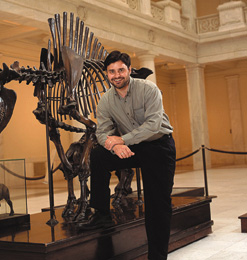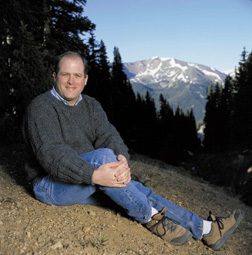geotimesheader
Society
Page
This month's Society Page
is a special
feature on three outstanding
members
of the earth science community.
______________________ |
To
post news in Society Page, send e-mail to geotimes@agiweb.org
with the subject: Society Page. |
Interviews
with
EARTH
SCIENCE 'GENIUSES'
The MacArthur Fellows
This year the John D. and Catherine T. MacArthur Foundation honored
three earth scientists among its 25 MacArthur fellows to receive $500,000
each over the next five years.
Since 1981, the foundation has chosen 588 exceptionally creative individuals,
ranging in age from 18 to 82, with a track record of success and promise
for future advances. Teachers, activists, writers, scientists, artists
and others are chosen without their knowledge and judged in secret. Diverse
as the candidates are in their interests, winners often share similar characteristics
of scholarship, artistic achievement, creativity and dedication to public
service. The fellowships, which are often unofficially referred to as ‘genius
grants,’ are provided to encourage outstanding achievers and are given
with “no strings attached” to help them with their own pursuits.
In the field this summer, K. Christopher Beard, associate curator of
vertebrate paleontology at the Carnegie Museum of Natural History in Pittsburgh;
Carl Safina, vice president for the Marine Conservation program of the
National Audubon Society; and Daniel Schrag, professor of geochemistry
at Harvard University, started working on their wish lists. Geotimes
caught up with the earth science winners on the road.
Christopher
Beard
| “I am checking email from Lhasa, Tibet, where I’ve been doing field
work for the past five weeks or so,” Beard says. Working with scientists
from Beijing’s Institute of Vertebrate Paleontology and Paleoanthropology,
Beard and colleagues were searching for the first early Cenozoic vertebrates
from Tibet. “Lately, most of my field projects have been based in Asia
because it seems that this vast landmass was particularly crucial during
early mammal phylogeny.” The foundation identified Beard as someone who
“consistently exhibited a willingness to challenge traditional ideas and
propose bold alternative interpretations.”
Beard, 38, is a member of the Society of Vertebrate Paleontology and
has worked extensively on the early Cenozoic primate evolution in Asia.
He helped clarify the evolution of North American mammals across the Paleocene-Eocene
boundary. He earned his doctorate in 1989 from the Johns Hopkins University
School of Medicine. In 1995, he and colleagues excited paleontologists
with the discovery along the Yellow River in southern China of a complete
40-million-year-old anthropoid’s lower dentition. The find of the early
primate, along with other specimens, predated the earliest known African
forms and led Beard to postulate that primitive anthropoids originated
in Asia first.
|

Chris
Beard next to a Pleistocene bison skeleton.
Photos
courtesy of the MacArthur Foundation. |
The dramatic evolutionary radiation of mammals that occurred during the
early Cenozoic fascinates Beard. “It is obviously a textbook case of adaptive
radiation,” he says. “It also is highly relevant to the world we’ve inherited,
because the evolutionary roots of the planet’s extant biota, including
ourselves, can for the most part be traced back to this interval.”
When he received the phone call from the MacArthur Foundation in June
he was surprised. “The MacArthur Fellows Program is very broad in its scope,
extending from science to the arts and social and political activism. Even
within my own small discipline there are many people who richly deserve
such an award. So, to be selected is a humbling experience.” He believes
his selection shows that “fundamental research in paleontology, often in
a museum setting, remains a truly exciting human endeavor.” He may
use some of the money to buy a new SUV for fieldwork in Wyoming.
Dan
Schrag
| Dan Schrag is a talker, so when he first learned he had won the MacArthur
Fellowship he was stunned: he had to keep it a secret for five days. “You’re
bubbling with this news, and you can’t let anybody else know,” he
says. His next hardest task will be in determining how to spend the money.
At 34, the young geochemist and member of the American Geophysical Union
has “blazed diverse trails through paleoceanography and oceanography in
his work on oxygen isotope chemistry of marine fossils, early global glaciation
of the Earth, and physical oceanography,” the foundation says. His interpretation
that the temperature of the deep ocean during the last ice age came close
to freezing has helped resolve a long-standing debate. Schrag received
much attention recently for revealing that the biosphere came close to
shutting down several times when the Earth was apparently blanketed with
glacial ice. Indeed, this summer, as he reexamined unusual carbonate rocks
on top of glacial deposits in Namibia, BBC filmed Schrag and colleague
Paul Hoffman as part of an upcoming documentary on the Snowball Earth theory. |

Dan Schrag
in Steamboat Springs, Colo. |
Schrag earned his doctorate in 1993 from the University of California,
Berkeley. He now works as professor of geochemistry and director of the
Laboratory for Geochemical Oceanography at Harvard University and considers
his laboratory a “geochemical playground.” His research also includes reconstructing
El Niño climatic oscillations over a range of time scales from recent
decades to the geologic past, and working with Mark Cane of Columbia University
on modeling the shallow circulation of the tropical Pacific ocean. Both
at Harvard and as an undergraduate at Yale he has also worked closely with
colleagues involved in science policy. He teaches courses at the John F.
Kennedy School of Government and may use the fellowship to pursue his interest
in how science is used in making policy decisions.
“I want to find a use for the money that is a little bit untraditional.”
One idea of his is to bring scientists together in an informal environment.
“Colleagues
in my field are my friends, and that social interaction is an enormous
part of how I come up with new ideas and how I carry out the science,”
he says. “Bringing those people together would be a way to use the money
in the spirit in which it is given.”
Carl
Safina
In the Galápagos this summer, Safina left his home in Islip,
N.Y., to study the habits of albatross; his next book will follow their
travels to elucidate the major ways the oceans are changing. “I want my
work to give people images of the ocean, which now is conceived of as a
blank blue space,” he says. “We have images that spring to mind when you
say Serengeti or Amazon rain forest. We need to carry with us images of
what is happening on the other two thirds of the planet.”
A public advocate as well as scientist and writer, “Safina demonstrates
a determination to reach beyond a scientific or traditional environmental
audience to the broader public in the interest of calling attention to
a growing crisis in marine resources,” the MacArthur Foundation says. “His
creative use of scientific and communication skills has encouraged various
regulatory bodies to acknowledge new scientific developments and to move
toward better protection of the environment.”
Safina, 45, founded the National Audubon Society’s Living Oceans Program
and was the author of Song for the Blue Ocean, a book heralded as a testimony
for marine conservation. He earned his doctorate from Rutgers University
in 1987. When the call from the MacArthur Foundation came he thought his
life would never be the same. “It’s like winning the lottery with your
mind as the ticket, or being told in a sudden phone call that your brain
has just won a gold medal.” He will use the money to help make the time
he needs for writing. |

Carl
Safina in Vancouver, Canada. |
Safina is accustomed to the “usual minor tribulations of fieldwork in
the Third World or in any airport counter anywhere.” But the most difficult
aspect of his work is “knowing you have all the information and arguments
yet losing a round due solely to political lobbyists backed by campaign
contributions. That’s harder to take than any number of mosquitoes or stormy
seas.”
By the time the fellowship ends, Safina hopes to see “the beginnings
of real management that limits [fish] catches in ways that turn population
trajectories of marine wildlife upward for the first time in decades.”
Ideally in the next five years he would like for marine wildlife sanctuaries
to include no fishing zones. And he calls for an end to “subsidies that
prop up bloated fleets incapable of surviving in real market circumstances.”
Associate Editor Christina Reed compiles
Society Page.



